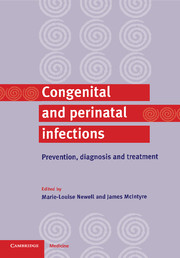Book contents
- Frontmatter
- Contents
- List of contributors
- Preface
- Part I General issues
- Part II Specific infections
- 5 Rubella infection in pregnancy
- 6 Perinatal Group B streptococcal infections
- 7 Mother-to-child transmission of cytomegalovirus
- 8 Varicella
- 9 Herpes simplex
- 10 Vertical transmission of hepatitis viruses
- 11 Papillomavirus infections as a perinatal problem: diagnosis, prevention and management
- 12 HIV-1 infection
- 13 Syphilis: prevention, diagnosis and management during pregnancy and infancy
- 14 The other sexually transmitted diseases
- 15 Toxoplasmosis
- 16 Neonatal sepsis
- Index
13 - Syphilis: prevention, diagnosis and management during pregnancy and infancy
Published online by Cambridge University Press: 06 July 2010
- Frontmatter
- Contents
- List of contributors
- Preface
- Part I General issues
- Part II Specific infections
- 5 Rubella infection in pregnancy
- 6 Perinatal Group B streptococcal infections
- 7 Mother-to-child transmission of cytomegalovirus
- 8 Varicella
- 9 Herpes simplex
- 10 Vertical transmission of hepatitis viruses
- 11 Papillomavirus infections as a perinatal problem: diagnosis, prevention and management
- 12 HIV-1 infection
- 13 Syphilis: prevention, diagnosis and management during pregnancy and infancy
- 14 The other sexually transmitted diseases
- 15 Toxoplasmosis
- 16 Neonatal sepsis
- Index
Summary
Introduction
Congenital syphilis is a serious and preventable disease, which remains an important cause of infant morbidity and mortality (Sciarra, 1997; Finelli et al., 1998). Treponema pallidum can be transmitted from an infected woman to her fetus, particularly when the mother presents with syphilis in the primary, secondary or early latent stage (Fiumara, 1952). In adults the primary lesion appears at the initial site of the infection about 3 weeks after exposure, followed by a more generalized illness involving skin rashes and condylomatalata after 6–12 weeks (secondary syphilis). If untreated, this stage is self-limited and the patient usually progresses to a latent stage of infection during which the only evidence of syphilis is positive serology. During the early latent phase (within 2 years of onset) organisms can be seeded intermittently into the blood stream.
Transmission from mother to infant can occur after at any stage of pregnancy, so that early antenatal serological screening with treatment of infected women prevents most cases of congenital syphilis (Sanchez et al., 1996). Detection in late pregnancy is less effective, but may prevent some of the sequelae. Untreated syphilis in pregnancy may result in significant perinatal mortality and morbidity, the risk depending on the stage of infection in the mother and levels of spirochetes in the blood stream (Wendel, 1988; Larkin et al., 1998). During the first 2 years of untreated latent maternal infection an estimated 20% of infants will die in utero or in the neonatal period, 20% will be premature but otherwise normal, 40% will be infected and damaged and 20% will be uninfected (McDermott et al., 1993).
- Type
- Chapter
- Information
- Congenital and Perinatal InfectionsPrevention, Diagnosis and Treatment, pp. 258 - 275Publisher: Cambridge University PressPrint publication year: 2000



